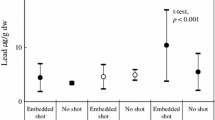Abstract
Studies were conducted on the feasibility of sampling the blood from live mourning doves (Zenaida macroura) as a technique for evaluating lead exposure in this species. Measurements of the blood enzyme, delta-aminolevulinic acid dehydratase (ALAD), were essentially the same in blood from the brachial vein or trunk blood. The ALAD activity decreased as liver lead concentration increased in mourning doves. Mourning doves that ingested lead shot had elevated lead concentrations in their femur bones and livers as compared to other doves which had not recently ingested lead shot.
Similar content being viewed by others
References
Bagley, G. E., L. N. Locke, and G. T. Nightingale: Lead poisoning in Canada geese. Avian Dis.11, 601 (1967).
Barr, A. J., J. H. Goodnight, J. P. Sall, and J. T. Helwig: A user's guide to SAS 76. Raleigh, NC: SAS Institute (1976).
Bellrose, F. C.: Lead poisoning as a mortality factor in waterfowl populations. Illinois Nat. Hist. Surv. Bull.27, 235 (1959).
Burch, H. B., and A. L. Siegel: Improved method for measurement of delta-aminolevulinic acid dehydratase activity of human erythrocytes. Clin. Chem.17, 1038 (1971).
Dieter, M. P., and M. T. Finley: Delta-amino-levulinic acid dehydratase enzyme activity in blood, brain, and liver of lead-dosed ducks. Environ. Res.19, 127 (1979).
Dieter, M. P., an M. T. Finley: Erythrocyte delta-aminolevulinic acid dehydratase activity in mallard ducks: Duration of inhibition after lead shot dosage. J. Wildl. Manage.42, 621 (1978).
Dieter, M. P., M. C. Perry, and B. M. Mulhern: Lead and PCBs in canvasback ducks: Relationship between enzyme levels and residues in blood. Arch. Environ. Contam. Toxicol.5, 1 (1976).
Getz, L. L., L. B. Best, and M. Prather: Lead in urban and rural songbirds. Environ. Pollut.12, 235 (1977).
Hunter, B. F., and M. N. Rosen: Occurrence of lead poisoning in a wild pheasant (Phasianus colchicus). Calif. Fish Game51, 207 (1965).
Kendall, R. J.: Toxicity and persistence of mirex in bobwhite quail in field and laboratory studies. M. S. Thesis, Clemson University, Clemson (1976).
—: The toxicology of lead shot and environmental lead ingestion in avian species with emphasis on the biological significance in mourning dove populations. Ph.D. Dissertation. Virginia Polytechnic Institute and State University, Blacksburg, VA (1980).
Kendall, R. J., and P. F. Scanlon: Lead concentrations in mourning doves collected from middle Atlantic game management areas. Proc. Southeastern Assoc. Fish Wildl. Agencies33, 165 (1979).
Lewis, J. C., and E. Legier, Jr.: Lead shot ingestion by mourning doves. J. Wildl. Manage.32, 476 (1968).
Locke, L. N., and G. E. Bagley: Lead poisoning in a sample of Maryland mourning doves. J. Wildl. Manage.31, 515 (1967).
Mirarchi, R. E.: Determination of the persistence of crop gland activity in mourning doves and the significance of crop gland persistence in mourning dove management in Virginia. Ph.D. Dissertation, Virginia Polytechnic Institute and State University, Blacksburg VA (1978).
Roscoe, D. E.: Pathology of plumbism in waterfowl and development of a simple diagnostic blood test. Ph.D. Dissertation. The Univ. of Connecticut, Storrs (1978).
Scanlon, P. F., V. D. Stotts, R. G. Oderwald, T. J. Dietrick, and R. J. Kendall: Lead concentrations in livers of Maryland waterfowl with and without ingested lead shot present in gizzards. Bull. Environ. Contam. Toxicol.,25, 855 (1980).
Steel, R. G. D., and J. H. Torrie: Principles and procedures in statistics. New York: McGraw-Hill (1960).
Westemeier, R. L.: Apparent lead poisoning in a wild bobwhite. Wilson Bull.78, 471 (1966).
Author information
Authors and Affiliations
Rights and permissions
About this article
Cite this article
Kendall, R.J., Scanlon, P.F. Tissue lead concentrations and blood characteristics of mourning doves from Southwestern Virginia. Arch. Environ. Contam. Toxicol. 11, 269–272 (1982). https://doi.org/10.1007/BF01055202
Received:
Accepted:
Issue Date:
DOI: https://doi.org/10.1007/BF01055202




